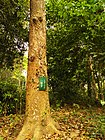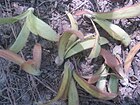Note: This is a project under development. The articles on this wiki are just being initiated and broadly incomplete. You can Help creating new pages.
Difference between revisions of "Shorea robusta - Agnivallabha"
| Line 8: | Line 8: | ||
==Chemical Composition== | ==Chemical Composition== | ||
| + | The oleoresin of the Shorea robusta Gaertn is called as Shala niryasa, Kala, Sarja rasa which has the chemical constituents such as nor-triterpene, dammarenolic acid, asiatic acid, dipterocarpol, triterpenic acid, tannic acid and phenolic content and possesses antibacterial, analgesic and wound healing effect.<ref name="Chemical Composition"/> | ||
==Common names== | ==Common names== | ||
| Line 81: | Line 82: | ||
==References== | ==References== | ||
<references> | <references> | ||
| − | <ref name="Uses">[https://easyayurveda.com/2012/10/03/sal-tree-shorea-robusta-ayurveda-details-and-health-benefits/ | + | <ref name="Uses">[https://easyayurveda.com/2012/10/03/sal-tree-shorea-robusta-ayurveda-details-and-health-benefits/ Uses]</ref> |
| − | <ref name="Leaf">[https://indiabiodiversity.org/species/show/231143 | + | <ref name="Leaf">[https://indiabiodiversity.org/species/show/231143 BOTANIC DESCRIPTION]</ref> |
| − | <ref name="Common names">[http://envis.frlht.org/bot_search | + | <ref name="Common names">[http://envis.frlht.org/bot_search Vernacular names]</ref> |
| − | <ref name="Ayurvedic preparations">[https://easyayurveda.com/2012/10/03/sal-tree-shorea-robusta-ayurveda-details-and-health-benefits/ | + | <ref name="Ayurvedic preparations">[https://easyayurveda.com/2012/10/03/sal-tree-shorea-robusta-ayurveda-details-and-health-benefits/ Ayurvedic preparations]</ref> |
| + | <ref name="Chemical Composition">[https://www.ncbi.nlm.nih.gov/pmc/articles/PMC3336301/ Chemical composition]</ref> | ||
</references> | </references> | ||
Latest revision as of 18:28, 7 August 2020
Agnivallabha is an evergreen tree with an elongated crown when young, becoming more rounded as the tree ages. It can grow up to 50 metres tall. The straight, cylindrical bole can be unbranched for up to 25 metres and up to 200cm in diameter. It is a very important multi-purpose tree. It is one of the main commercial timbers of India, being harvested from the wild for local use and export. It also yields a resin that is traded and an oil that is used locally as well as being exported in large quantities. In addition, it supplies tannins, an edible seed and medicines for local use. The leaves are used commercially for making plates and containers.
Contents
- 1 Uses
- 2 Parts Used
- 3 Chemical Composition
- 4 Common names
- 5 Properties
- 6 Habit
- 7 Identification
- 8 List of Ayurvedic medicine in which the herb is used
- 9 Where to get the saplings
- 10 Mode of Propagation
- 11 How to plant/cultivate
- 12 Commonly seen growing in areas
- 13 Photo Gallery
- 14 References
- 15 External Links
Uses
Fracture healing, Wound healing, Diarrhea, Ear disorders, Relieves itching.[1]
Parts Used
Bark, Sapwood, Heartwood, Resin, Seeds
Chemical Composition
The oleoresin of the Shorea robusta Gaertn is called as Shala niryasa, Kala, Sarja rasa which has the chemical constituents such as nor-triterpene, dammarenolic acid, asiatic acid, dipterocarpol, triterpenic acid, tannic acid and phenolic content and possesses antibacterial, analgesic and wound healing effect.[2]
Common names
| Language | Common name |
|---|---|
| Kannada | Ashvakarna, Bili-bhogimara, Bili-bovu, Bilibodige |
| Hindi | Sal, Ral, Shal |
| Malayalam | Kungiliyam, Mulappumarutu, Salavrksam |
| Tamil | Venkunkiliyam, Tanivirukkam, Acuvakarnakam |
| Telugu | Jalari-chettu, Saala, Sarjakamu |
| Marathi | NA |
| Gujarathi | NA |
| Punjabi | NA |
| Kashmiri | NA |
| Sanskrit | Agnivallabha, Ashvakarna, Dhupavrksa, Ralasala |
| English | Sal |
. [3]
Properties
Reference: Dravya - Substance, Rasa - Taste, Guna - Qualities, Veerya - Potency, Vipaka - Post-digesion effect, Karma - Pharmacological activity, Prabhava - Therepeutics.
Dravya
Rasa
Kashaya (Astringent), Madhura (Sweet)
Guna
Rooksha (Dry), Ushna (Hot)
Veerya
Sheeta (Cold)
Vipaka
Katu (Pungent)
Karma
Prabhava
Habit
Identification
Leaf
{{Leaf|Simple|Alternate|Shiny, glabrous, about 10-25 cm long and broadly oval atthe base, with the apex tapering into a long point; new leaves reddish, soon becoming delicate green. }[4]
Flower
| Type | Size | Color and composition | Stamen | More information |
|---|---|---|---|---|
| Bisexual | Terminal or axillary racemose panicles | Yellowish white | 25+ | fragrant, yellow or cream white, pedicel subsessile, bracts minute, caducous, calyx 5 lobed, tubular with short valvate lobes, imbricate, ovate-triangular. |
Fruit
| Type | Size | Mass | Appearance | Seeds | More information |
|---|---|---|---|---|---|
| Winged capsule | 1.5 cm long | Ovoid, apex acute, densely pubescent, about 1.5 cm long, enclosed in calyx tube with 3 outer accrescent larger lobes and broader lobes, about 8 x 1.5 cm long and 2 inner ones. | {{{5}}} | {{{6}}} |
Other features
List of Ayurvedic medicine in which the herb is used
Where to get the saplings
Mode of Propagation
How to plant/cultivate
Season to grow
Soil type
Propagation
Commonly seen growing in areas
Photo Gallery
References
External Links
- Ayurvedic Herbs known to be helpful to treat Fracture healing
- Ayurvedic Herbs known to be helpful to treat Wound healing
- Ayurvedic Herbs known to be helpful to treat Diarrhea
- Ayurvedic Herbs known to be helpful to treat Ear disorders
- Ayurvedic Herbs known to be helpful to treat Relieves itching
- Herbs with Bark used in medicine
- Herbs with Sapwood used in medicine
- Herbs with Heartwood used in medicine
- Herbs with Resin used in medicine
- Herbs with Seeds used in medicine
- Herbs with common name in Kannada
- Herbs with common name in Hindi
- Herbs with common name in Malayalam
- Herbs with common name in Tamil
- Herbs with common name in Telugu
- Herbs with common name in Sanskrit
- Herbs with common name in English
- Habit - Tree
- Index of Plants which can be propagated by Seeds
- Herbs that are commonly seen in the region of Sub Tropical area
- Herbs
- Dipterocarpaceae







